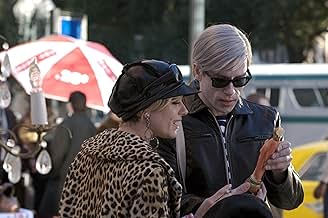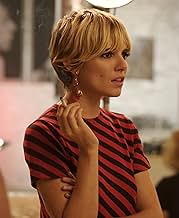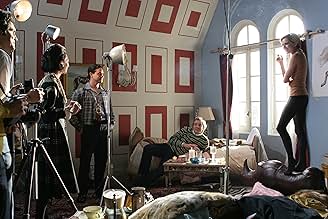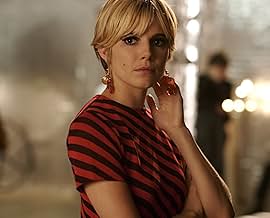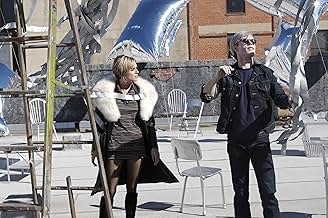Based on the rise and fall of socialite Edie Sedgwick, concentrating on her relationships with Andy Warhol and a folk singer.Based on the rise and fall of socialite Edie Sedgwick, concentrating on her relationships with Andy Warhol and a folk singer.Based on the rise and fall of socialite Edie Sedgwick, concentrating on her relationships with Andy Warhol and a folk singer.
- Awards
- 1 nomination total
Featured reviews
Just in case you read some of the rather hysterical comments and garner the impression that it's supposed to be about real people, it's not. Andy Warhol was never a real person, just a performance.
Guy Pearce presents Andy Warhol as the superficial creature he undoubtedly was. The original art-as-business creator, the very God at whose altar such modern day charlatans as Damien Hirst worship. Pearce's performance is riveting, his Andy Warhol is as empty as his crapulous art; just a two-dimensional diagram of someone who leaves no shadow. A cartoon.
Sienna Miller's performance as Edie Sedgewick is the best thing she's ever done. Caught in the strobe lights of Warhol's strangely sterile world of non-sexual sex and sofas still in their plastic wrappers, Edie becomes the focus of his short attention span for a while. She flashes across the screen like a speeded up Holly Golighty, while Warhol's voyeuristic viewfinder traps her in it's leering stare. The camera loves her and so does Warhol. But we know it's going to end in tears.
Nothing in the movie has much depth, none of the characters are developed beyond what we already know about them and the whole sixties New York scene is represented by a series of iconic "things". The Chelsea Hotel, the Velvet Underground, a soundtrack of songs that sound right but which actually don't fit at all. For instance, "Leavin' here" by The Birds, a British group in which Ronnie Wood was the guitarist, was recorded in 1966 but was never released in America. However, there it is on the soundtrack being played in the factory sometime in 1965.
But no matter.
The movie pretty much captures the shallow, transient and utterly facile world of Warhol in the sixties and in another way it sums up the emptiness and tragedy of the Hollywood dream machine too. But it doesn't ask any deep questions nor does it pretend to be something it's not. It's entertaining and worth watching for two very good performances by Guy Pearce and Sienna Miller.
It's not art, it's just a movie, albeit a superficial one.
Did Hickenlooper paint Edie as a perpetual victim (notice how throughout the film she is never injecting herself but is bent over while others inject her?) just so that he could show her as a victim of Andy Warhol and his drug fiend factory friends? Or that she was always a victim of people like her friend Chuck who did a complete turn on her for that villain Andy? Is Hickenlooper trying to say that the biggest mistake of Edie's life was not choosing Dylan over Warhol in that elevator scene where her future self voices over, "that was the biggest mistake of my life"? Edie Sedgwick came to the factory a sick person, she was already headed for a crash even before she set eyes on Andy Warhol. In reality, she was rejected by the factory friends and many others for the drugs she brought with her everywhere, she was not introduced to them at the factory as the movie shows.
Hickenlooper seems to me to be trying to say that Edie Sedgwick, that fresh faced wasp in knee socks and pearls who left Cambridge with sketches tucked under her arms could have potentially had a wonderful and peaceful life, even a stable marriage with Bob Dylan had she only not met Andy Warhol and been subject of those movies.
I have a problem with this film because I am so interested, most people are, in the real Edie Sedgwick and I agree with another poster who suggested you see Ciao!Manhattan to get a better sense of who she was. If you want a tragic love-story about a good girl who chose the wrong guy, watch Factory Girl.
The real Edie Sedgwick was a person whose hystrionics and drugs were symptoms of a soul that was always trying to fly away, for her the world was always too small and her pain was always too big, and she lived her life as though she dreamed of having her wings singed flying too close to the sun.
With her big raccoon eyes, pre-punk hairdo and flashing smile, Miller bears such a striking resemblance to the real-life Sedgwick that she carries much of the film by the sheer will of her character's Holly Golightly-like sense of exalted self-worth. But like Holly, Sedgwick lacked talent to sustain a film career, and the script leaves Miller to her own devices in connecting us with her character's tormented psyche amid her escalating drug use. On the upside, Guy Pearce accurately captures the discomfiting public image of Warhol down to the familiar narcissistic indifference and manipulative shyness, but his character gradually recedes into the background. At first, Hayden Christensen comes across as amateurish and unintentionally amusing as a Bob Dylan doppelganger, especially since he makes a feeble attempt at capturing the singer's recognizable speech cadences. Just as he manages to transcend the awkwardness of the character's intrusion into the story, he also disappears making his impact in Sedgwick's life feel rather fleeting.
Even though the cryptic screenplay by Captain Mauzner, Aaron Richard Golub and Simon Monjack conveniently paints Warhol and the faux-Dylan as polarizing figures pulling at Sedgwick's soul, the story really comes down to her own inner demons. The problem is that she remains oddly elliptical throughout, and Hickenlooper seems satisfied with leaving us with an impressionistic view of a person who barely warrants our attention forty years later. Among the supporting players, there are quite a familiar faces - Ileana Douglas as Vogue editor Diana Vreeland, Jimmy Fallon as Sedgwick's confidante Chuck Wein, Tara Summers as fellow Warhol protégé Brigid Berlin, Mena Suvari as Brigid's sister Richie, Edward Herrmann as the family attorney, Mary Kate Olsen as a partygoer. However, none of them are given any opportunity to shine.
Another goof I caught in the movie was when Edie was listing all the popular drugs at the Factory, was that Adderall was mentioned. This drug did not come out until 1996. I was rather surprised it was mentioned, because if they had been on methylphenidate at the time, Ritalin was probably their drug of choice. It was available at the time. I myself have been on Adderall (for ADHD) for a very brief period in the 90s, and it was really horrible...I can't possibly imagine anyone wanting to be on that thing.
In the 90s I knew a guy who had been Warhol's room mate in the 1950s and a very, very minor character in Andy's later life, I asked him once if he ever knew Edie, and he just groaned and said, "she was the MOST BORING girl I ever met in my life." End of discussion.
Did you know
- TriviaSienna Miller improvised the scene in which Edie tells The Musician about her brothers' deaths.
- GoofsEdie Sedgwick's relationship to Nico is depicted incorrectly: in reality they were friends and Edie warned Nico about Andy Warhol's behavior. Edie's death was very sad for Nico.
- Quotes
Andy Warhol: I wonder if people are going to remember us?
Edie Sedgwick: What, when we're dead?
Andy Warhol: Yeah.
Edie Sedgwick: Well, I think people will talk about how you changed the world.
Andy Warhol: I wonder what they'll say about you... in your obituary. I like that word.
Edie Sedgwick: Nothing nice, I don't think.
Andy Warhol: No no, come on. They'd say, "Edith Minturn Sedgwick: beautiful artist and actress...
Edie Sedgwick: ...and all-around loon.
Andy Warhol: ...Remembered for setting the world on fire...
Edie Sedgwick: ...and escaping the clutches of her terrifying family...
Andy Warhol: ...Made friends with eeeeverybody and anybody...
Edie Sedgwick: ...creating chaos and uproar wherever she went. Divorced as many times as she married, she leaves only good wishes behind.
[laughs]
Edie Sedgwick: That's nice, isn't it?
- Crazy creditsDuring the first part of the end credits, photos are shown of the real Edie Sedgwick. Also people who knew her give testimonies about her.
- Alternate versionsAccording to the FAQ section: "For the home theatre market, an unrated version was released aside from the R-rated theatrical version. Most scenes which were re-inserted or alternately shifted, serve to specify character drawings and various aspects of the story which were only embedded in the theatrical version to some extent. However, there are also a few extensions with sexual contents and more explicit depictions of drug use."
- SoundtracksDino's Song
Written by Chet Powers (uncredited)
Performed by Quicksilver Messenger Service
Courtesy of Capitol Records
Under License from EMI Film & Television Music
- How long is Factory Girl?Powered by Alexa
- What did Edie's brother say that he tasted until the day he died?
- Why is Hayden Christensen's character listed as "Musician" and no longer as Billy Quinn?
- What are the differences between the Theatrical Version and the Unrated Version?
Details
Box office
- Budget
- $7,000,000 (estimated)
- Gross US & Canada
- $1,675,241
- Gross worldwide
- $3,572,632
- Runtime1 hour 40 minutes
- Color
- Sound mix
- Aspect ratio
- 1.85 : 1
Contribute to this page




